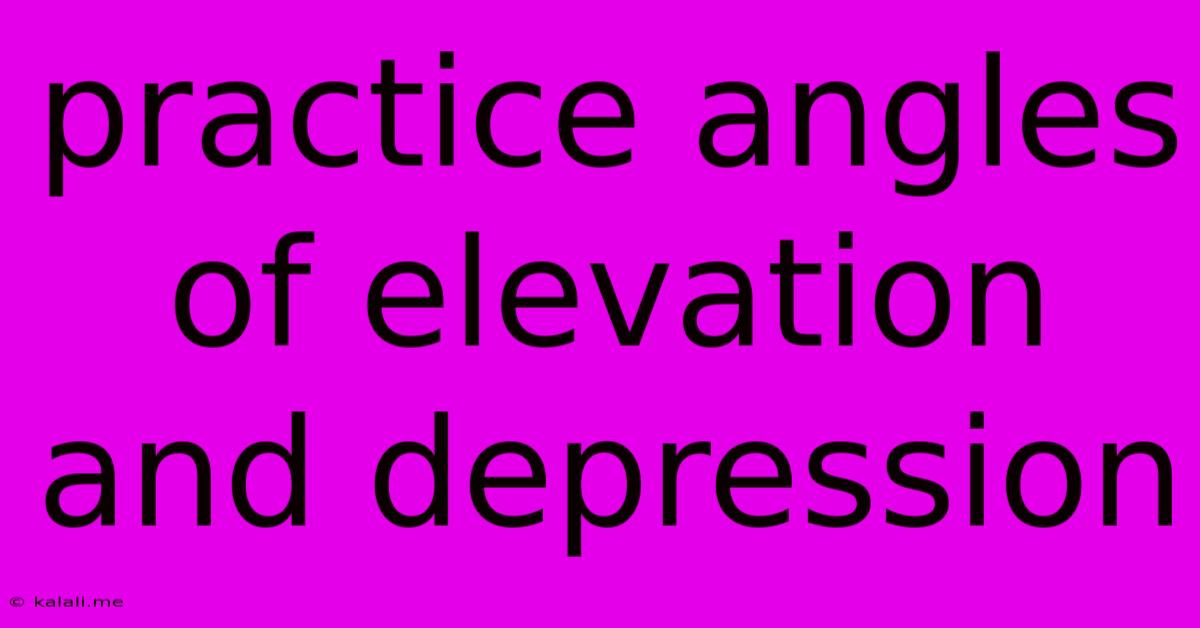Practice Angles Of Elevation And Depression
Kalali
May 10, 2025 · 4 min read

Table of Contents
Mastering Angles of Elevation and Depression: A Comprehensive Guide
This article provides a comprehensive guide to understanding and solving problems involving angles of elevation and depression. We'll cover the definitions, common applications, and practical strategies for tackling various problem types. Mastering these concepts is crucial for anyone studying trigonometry and its real-world applications in fields like surveying, navigation, and architecture.
What are Angles of Elevation and Depression?
Angles of elevation and depression are crucial concepts in trigonometry used to describe the angle between a horizontal line and the line of sight to an object. They are always measured from the horizontal.
-
Angle of Elevation: This is the angle formed between the horizontal line of sight and the upward line of sight to an object that is above the horizontal. Imagine looking up at a bird in the sky; the angle your line of sight makes with the horizontal is the angle of elevation.
-
Angle of Depression: This is the angle formed between the horizontal line of sight and the downward line of sight to an object that is below the horizontal. Think about looking down from a cliff to a boat at sea; the angle your line of sight makes with the horizontal is the angle of depression.
It's important to note that the angle of elevation and the angle of depression between two points are always equal. This is due to the property of alternate interior angles formed by parallel lines (the horizontal line of sight and the ground).
Understanding the Problem-Solving Process
Solving problems involving angles of elevation and depression typically involves using trigonometric ratios: sine, cosine, and tangent. These ratios relate the angles of a right-angled triangle to the lengths of its sides. Remember SOH CAH TOA:
- SOH: Sine = Opposite / Hypotenuse
- CAH: Cosine = Adjacent / Hypotenuse
- TOA: Tangent = Opposite / Adjacent
The key is to correctly identify the relevant sides of the right-angled triangle formed by the observer, the object, and the horizontal line.
Common Problem Types and Strategies
Let's explore some common scenarios and the strategies used to solve them:
Scenario 1: Finding the Height of an Object
Imagine you're standing a certain distance from a building, and you measure the angle of elevation to the top of the building. You know your distance from the building. To find the building's height:
-
Draw a diagram: This is crucial! Sketch a right-angled triangle with the building's height as the opposite side, your distance from the building as the adjacent side, and the angle of elevation as the angle.
-
Identify the relevant trigonometric ratio: Since we know the adjacent and want to find the opposite, we'll use the tangent ratio (Tangent = Opposite / Adjacent).
-
Solve the equation: Rearrange the formula to solve for the opposite side (building's height).
Scenario 2: Finding the Distance to an Object
Suppose you're on a cliff overlooking the sea, and you observe a boat. You know the height of the cliff and the angle of depression to the boat. To find the distance of the boat from the base of the cliff:
-
Draw a diagram: Sketch a right-angled triangle. The height of the cliff is the opposite side, the distance to the boat is the adjacent side, and the angle of depression is the angle.
-
Identify the relevant trigonometric ratio: We know the opposite and want to find the adjacent, so we use the tangent ratio.
-
Solve the equation: Rearrange the formula to solve for the adjacent side (distance to the boat).
Scenario 3: Problems involving multiple angles and triangles
Some problems require breaking down the situation into multiple right-angled triangles and using the solution of one triangle to solve another. This might involve applying trigonometric ratios multiple times or using geometric principles like alternate interior angles or vertical angles. Always draw a detailed diagram to visualize these complex scenarios.
Tips for Success
- Always draw a diagram: This helps visualize the problem and identify the relevant sides and angles.
- Label your diagram: Clearly label all known values (angles and lengths) and the unknown value you need to find.
- Choose the correct trigonometric ratio: Carefully select the ratio (sine, cosine, or tangent) based on the known and unknown sides of the triangle.
- Show your working: Clearly show each step of your calculations to avoid errors and to allow for easy checking.
- Practice regularly: The more problems you solve, the more confident and proficient you'll become.
Mastering angles of elevation and depression requires a strong understanding of trigonometry and a systematic approach to problem-solving. By following the strategies outlined here and practicing regularly, you can confidently tackle a wide range of problems in this important area of mathematics.
Latest Posts
Latest Posts
-
Words That Start With Y In Science
Jul 12, 2025
-
Prevent An Expressway Emergency By Merging Without
Jul 12, 2025
-
How Many Grams Of Sugar In A Pound
Jul 12, 2025
-
7am To 11am Is How Many Hours
Jul 12, 2025
-
If Your 35 What Year Was You Born
Jul 12, 2025
Related Post
Thank you for visiting our website which covers about Practice Angles Of Elevation And Depression . We hope the information provided has been useful to you. Feel free to contact us if you have any questions or need further assistance. See you next time and don't miss to bookmark.